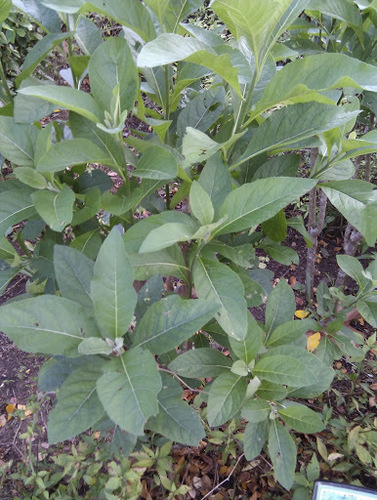Vernonia amygdalina

|
|
Vernonia amygdalina Common Names: Bitter Leaf, African Bitter Leaf,
Ironweed Scientific
Classification Kingdom: Plantae Clade: Tracheophytes Clade: Angiosperms Clade: Eudicots Order: Asterales Family: Asteraceae Genus: Vernonia Species: V. amygdalina Binomial Name: Vernonia amygdalina Delile Synonyms: Gymnanthemum amygdalinum (Delile) Sch.Bip. Morphological Description Vernonia amygdalina, commonly known as Bitter Leaf, is a small shrub or tree,
typically 2–5 m tall, occasionally reaching 10 m in favorable conditions. It is
characterized by: · Stems: Rough, grey-brown bark, brittle branches with a woody base · Leaves: Lanceolate to oblong, 10–20 cm long, 4–7 cm wide, medium to
dark green, bitter-tasting, with finely toothed margins · Flowers: Small, creamy-white, thistle-like, 1 cm long, in dense
terminal clusters, blooming from October to February · Fruit: Small achenes, 1–2 mm long, with a bristly pappus aiding
wind dispersal Its bitter taste, due to
sesquiterpene lactones, is a defining trait (Farombi & Owoeye, 2011). Distribution and Habitat Vernonia amygdalina is native to tropical Africa, spanning from Senegal to South
Africa, with high prevalence in Nigeria, Cameroon, Zimbabwe, and Uganda. It is
cultivated in Asia (e.g., Malaysia) and parts of North America and Europe in
controlled environments. It thrives in: · Habitats: Riverbanks, lake margins, forest edges, woodlands,
grasslands · Climate: Tropical, with rainfall of 750–2,000 mm annually,
temperatures of 18–35°C · Soil Conditions: Prefers humus-rich, well-drained soils (pH
5.5–7.0), tolerates sandy or clayey soils · Elevation: Sea level to 2,800 m It requires full
sunlight and is resilient in disturbed areas (Orwa et al., 2009). Ethnopharmacology Vernonia amygdalina, commonly known as bitter leaf, is a widely used medicinal plant
in tropical Africa, renowned for its broad therapeutic potential.
Traditionally, the leaves, roots, and stems are used to treat a variety of
ailments, including malaria, diabetes, fevers, gastrointestinal disorders,
infections, and inflammatory conditions. The plant exhibits antimalarial,
antidiabetic, antimicrobial, anti-inflammatory, antioxidant, hepatoprotective,
and anticancer properties. It is particularly popular for managing blood sugar
levels and is often used by people with type 2 diabetes. Phytochemical studies
have identified bioactive compounds such as vernonioside, flavonoids, saponins,
alkaloids, sesquiterpene lactones, and tannins, which contribute to its wide
range of pharmacological effects. While many of its traditional uses have been
supported by laboratory studies, further clinical research is needed to
establish standardized dosages and confirm long-term safety in human
populations. · Antimicrobial: Leaf extracts inhibit *Staphylococcus aureus* (MIC 0.25
mg/mL) and *Escherichia coli* (MIC 0.5 mg/mL), used in Nigeria for infections
(Erasto et al., 2007). · Anti-inflammatory: Reduces paw edema in rats (60% at 200
mg/kg), used in Ghana for arthritis (Adedapo et al., 2014). · Antioxidant: DPPH scavenging (IC₅₀ 18 µg/mL), used in Cameroon for
oxidative stress (Erasto et al., 2007). · Diabetes Management: Lowers blood glucose by 50% in diabetic
rats (100 mg/kg), used in Nigeria for diabetes (Ijeh & Ejike, 2011). · Heart Health: Reduces LDL cholesterol by 30% in rats (200 mg/kg), used in
Togo for cardiovascular health (Adaramoye et al., 2008). · Digestive Health: Leaf infusions treat dysentery in Uganda,
with tannins aiding gut health (Yeap et al., 2010). · Malaria Treatment: Has anti-malarial property · Fertility/Reproductive Health: Leaf extracts enhance uterine contractions
in rats, used in Ethiopia for menstrual issues (Kamatenesi-Mugisha &
Oryem-Origa, 2007). · Detoxification: Protects liver from CCl₄ damage in rats
(ALT reduced by 45%), used in Nigeria for liver cleansing (Farombi &
Owoeye, 2011). · Cancer Prevention: Vernolide induces apoptosis in cancer
cells (IC₅₀ 10 µM), used in South Africa for tumor prevention (Toyang &
Verpoorte, 2013). ⚠ Toxicity Profile: No acute toxicity at traditional doses (LD₅₀
> 5,000 mg/kg in rats), but excessive use may cause nausea, hypoglycemia
(blood sugar < 50 mg/dL), or uterine stimulation. Pregnant women should
avoid it due to abortifacient risks; it may reduce iron absorption (Farombi
& Owoeye, 2011). Phytochemistry The plant’s medicinal
properties stem from a diverse phytochemical profile: · Sesquiterpene Lactones: Vernolide, vernodalin, vernomygdin, with
antimalarial and anticancer effects · Flavonoids: Luteolin, apigenin, providing antioxidant and
anti-inflammatory benefits · Alkaloids: Support antimicrobial and hypoglycemic actions · Saponins/Tannins: Aid digestion and detoxification · Steroids: Vernoniosides, linked to anti-inflammatory properties Additional Uses · Edible Uses: Leaves (rich in vitamins A, C, and iron) cooked as a
vegetable in soups across West Africa (Orwa et al., 2009) · Ethnoveterinary: Fed to livestock in Nigeria as a tonic and
dewormer · Zoopharmacognosy: Chimpanzees chew pith to expel parasites
(Huffman, 2003) · Topical Uses: Leaf sap applied to wounds and skin infections in Zimbabwe References
External Links More Pictures |
|
| Compounds of Vernonia amygdalina |
|
| References |